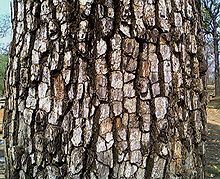- Diospyros melanoxylon
-
Coromandel Ebony 
Bark of the Coromandel Ebony. Scientific classification Kingdom: Plantae (unranked): Angiosperms (unranked): Eudicots (unranked): Asterids Order: Ericales Family: Ebenaceae Genus: Diospyros Species: D. melanoxylon Binomial name Diospyros melanoxylon
Roxb.[1]Synonyms Diospyros tupru Buch.-Ham.
Coromandel Ebony or East Indian Ebony (Diospyros melanoxylon) is a species of flowering tree in the family Ebenaceae that is native to India and Sri Lanka.
Its common name is derived from the coast of southeastern India, Coromandel; locally it is known as temburini or by its Hindi name tendu. In Orissa and Jharkhand it known as kendu. It is used in an Indian cigarette product known as a beedi, where it wraps the tobacco to be smoked. The bark of the East Indian ebony is hard and dry, and burns producing sparks and sounds.[vague]
Pharmacology
The leaf of the tree contains valuable flavones.[2] The pentacyclic triterpines found in leaves possess antimicrobial properties,[3] while the bark shows antihyperglycemic activity.[4] The bark of four diospyrose species found in India also found significant antiplasmocidal effects against P. falciparum.[5]
References
- ^ "Diospyros melanoxylon Roxb.". Germplasm Resources Information Network. United States Department of Agriculture. 2006-10-27. http://www.ars-grin.gov/cgi-bin/npgs/html/taxon.pl?403647. Retrieved 2009-04-09.
- ^ NEW FLAVONOIDS FROM THE LEAVES OF DIOSPYROS MELANOXYLON,Uppuluri V. Mallavadhani and Anita Mahapatra
- ^ Antimicrobial Activity of Some Pentacyclic Triterpenes and Their Synthesized 3-O-Lipophilic Chains,Uppuluri Venkata MALLAVADHANI,*,a Anita MAHAPATRA,a Kaiser JAMIL,b and Peddi Srinivasa REDDYb , Biol. Pharm. Bull. 27(10) 1576—1579 (2004) Vol. 27, No. 10
- ^ Antihyperglycemic effect of Diospyros melanoxylon (Roxb.) bark against Alloxan-induced diabetic rats Jadhav J. K*.Masirkar V. J., Deshmukh V. N.International Journal of PharmTech Research CODEN( USA): IJPRIF ISSN : 0974-4304 ,Vol.1, No.2, pp 196-200 , April-June 2009
- ^ Investigation of Indian Diospyros Species for Antiplasmodial Properties,V. S. Satyanarayana Kantamreddi and Colin W. Wright. eCAM 2008;5(2)187–190
Categories:- Diospyros
- Trees of India
- Flora of Sri Lanka
Wikimedia Foundation. 2010.
